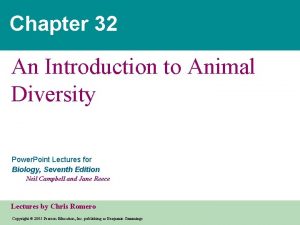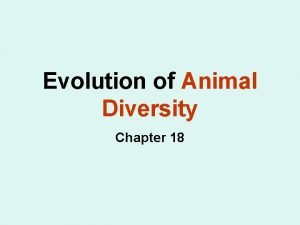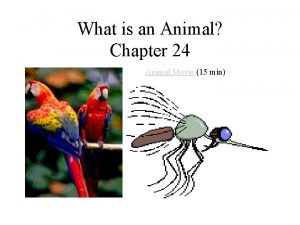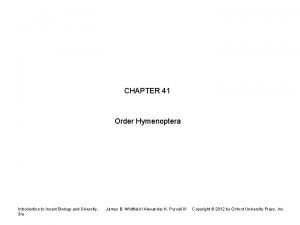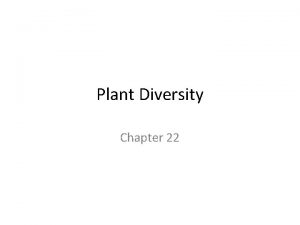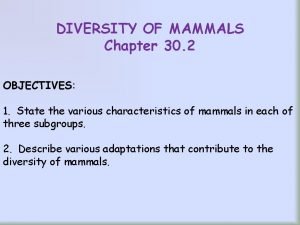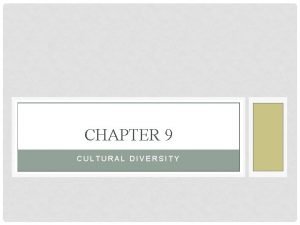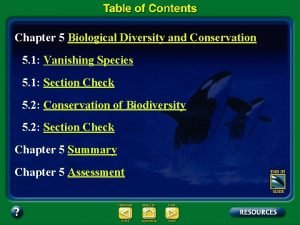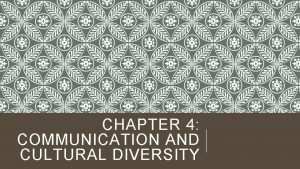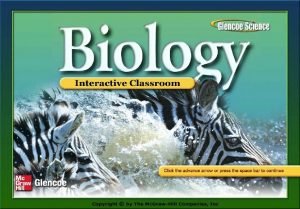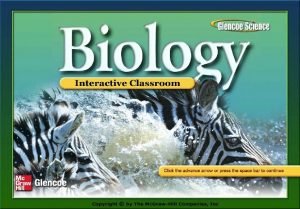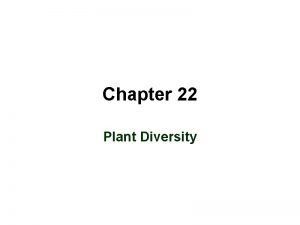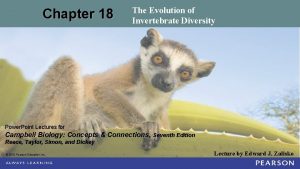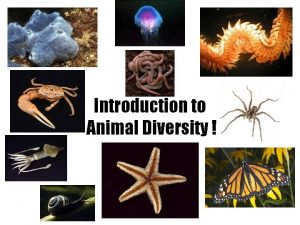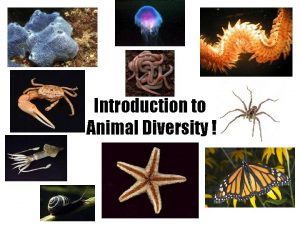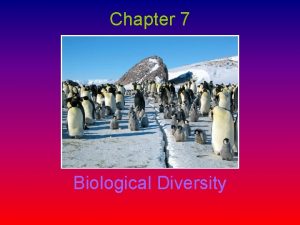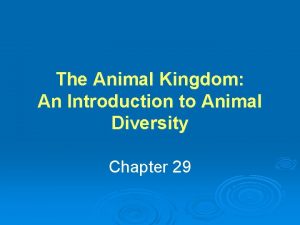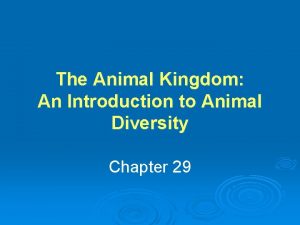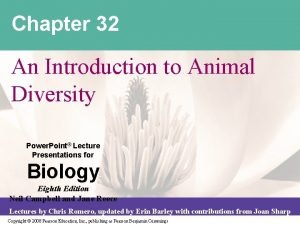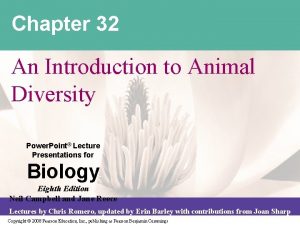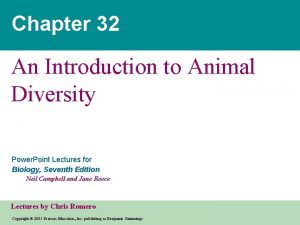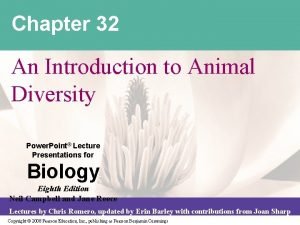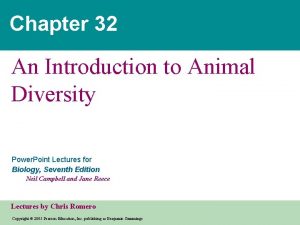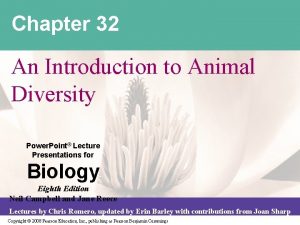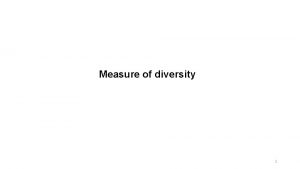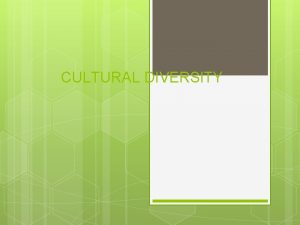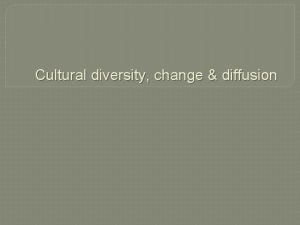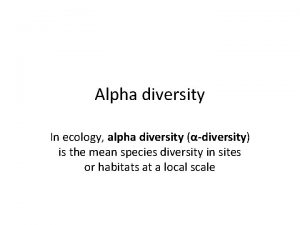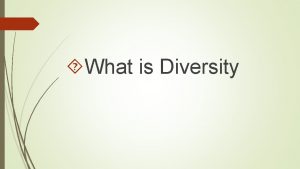Chapter 32 An Introduction to Animal Diversity Power
























- Slides: 24

Chapter 32 An Introduction to Animal Diversity Power. Point Lectures for Biology, Seventh Edition Neil Campbell and Jane Reece Lectures by Chris Romero Copyright © 2005 Pearson Education, Inc. publishing as Benjamin Cummings

Concept 32. 3: Animals can be characterized by “body plans” • Zoologists sometimes categorize animals according to morphology and development • A grade is a group of animal species with the same level of organizational complexity • A body plan is the set of traits defining a grade Copyright © 2005 Pearson Education, Inc. publishing as Benjamin Cummings

Symmetry • Animals can be categorized according to the symmetry of their bodies, or lack of it • Asymmetry– Absence of a central point or axis around which body parts are distributed. – Ex: protists, sponges Copyright © 2005 Pearson Education, Inc. publishing as Benjamin Cummings

• Some animals have radial symmetry, the form found in a flower pot. • Arrangement such that any plane passing through the oral-aboral axis divides the animal into mirror images – Ex. cnidarians Copyright © 2005 Pearson Education, Inc. publishing as Benjamin Cummings

LE 32 -7 a Radial symmetry

• The two-sided symmetry seen in a shovel is an example of bilateral symmetry • Arrangement such that a single plane, passing dorsoventrally through the longitudinal axis of an animal, will divide the animal into right and left mirror images. – Vertebrates – Humans Copyright © 2005 Pearson Education, Inc. publishing as Benjamin Cummings

LE 32 -7 b Bilateral symmetry

• Bilaterally symmetrical animals have: – A dorsal (top) side and a ventral (bottom) side – A right and left side – Anterior (head) and posterior (tail) ends – Cephalization, the development of a head Copyright © 2005 Pearson Education, Inc. publishing as Benjamin Cummings

Terms • Oral: • Aboral: • Superior: • Inferior: • Anterior: • Posterior: Copyright © 2005 Pearson Education, Inc. publishing as Benjamin Cummings

Tissues • Animal body plans also vary according to the organization of the animal’s tissues • Tissues are collections of specialized cells isolated from other tissues by membranous layers Copyright © 2005 Pearson Education, Inc. publishing as Benjamin Cummings

• Animal embryos have concentric layers called germ layers that form tissues and organs • Ectoderm is the germ layer covering the embryo’s surface • Endoderm is the innermost germ layer • Diploblastic animals have ectoderm and endoderm • Triploblastic animals also have an intervening mesoderm layer Copyright © 2005 Pearson Education, Inc. publishing as Benjamin Cummings

Body Cavities • In triploblastic animals, a body cavity may be present or absent • A true body cavity is called a coelom and is derived from mesoderm Copyright © 2005 Pearson Education, Inc. publishing as Benjamin Cummings

LE 32 -8 a Coelom Digestive tract (from endoderm) Coelomate Body covering (from ectoderm) Tissue layer lining coelom and suspending internal organs (from mesoderm)

• A pseudocoelom is a body cavity derived from the blastocoel, rather than from mesoderm Copyright © 2005 Pearson Education, Inc. publishing as Benjamin Cummings

LE 32 -8 b Body covering (from ectoderm) Pseudocoelom Digestive tract (from endoderm) Pseudocoelomate Muscle layer (from mesoderm)

• Acoelomates are organisms without body cavities Copyright © 2005 Pearson Education, Inc. publishing as Benjamin Cummings

LE 32 -8 c Body covering (from ectoderm) Wall of digestive cavity (from endoderm) Acoelomate Tissuefilled region (from mesoderm)

Protostome and Deuterostome Development • Based on early development, many animals can be categorized as having protostome or deuterostome development Copyright © 2005 Pearson Education, Inc. publishing as Benjamin Cummings

Cleavage • In protostome development, cleavage is spiral and determinate • In deuterostome development, cleavage is radial and indeterminate Copyright © 2005 Pearson Education, Inc. publishing as Benjamin Cummings

LE 32 -9 a Protostome development (examples: molluscs, annnelids, arthropods) Eight-cell stage Spiral and determinate Deuterostome development (examples: echinoderms, chordates) Eight-cell stage Radial and indeterminate Cleavage

Coelom Formation • In protostome development, the splitting of solid masses of mesoderm to form the coelomic cavity is called schizocoelous development • In deuterostome development, formation of the body cavity is described as enterocoelous development Copyright © 2005 Pearson Education, Inc. publishing as Benjamin Cummings

LE 32 -9 b Protostome development (examples: molluscs, annnelids, arthropods) Deuterostome development (examples: echinoderms, chordates) Coelom formation Coelom Archenteron Coelom Mesoderm Blastopore Schizocoelous: solid masses of mesoderm split and form coelom Blastopore Mesoderm Enterocoelous: folds of archenteron form coelom

Fate of the Blastopore • In protostome development, the blastopore becomes the mouth • In deuterostome development, the blastopore becomes the anus Copyright © 2005 Pearson Education, Inc. publishing as Benjamin Cummings

LE 32 -9 c Protostome development (examples: molluscs, annnelids, arthropods) Deuterostome development (examples: echinoderms, chordates) Mouth Anus Digestive tube Mouth develops from blastopore Anus develops from blastopore Fate of the blastopore
 Introduction to animal diversity
Introduction to animal diversity Animal diversity chapter
Animal diversity chapter Tiburonia granrojo
Tiburonia granrojo General features of animals
General features of animals Why is genetic diversity important
Why is genetic diversity important Genetic diversity vs species diversity
Genetic diversity vs species diversity Real power formula
Real power formula Diversity factor of a power system
Diversity factor of a power system Thread waisted wasp
Thread waisted wasp Plant and animal cell venn diagram
Plant and animal cell venn diagram Animal cell plant cell venn diagram
Animal cell plant cell venn diagram Similarities between animal rights and animal welfare
Similarities between animal rights and animal welfare Themes of animal farm with quotes
Themes of animal farm with quotes Chapter 22 plant diversity answer key
Chapter 22 plant diversity answer key Chapter 30 section 2 diversity of mammals
Chapter 30 section 2 diversity of mammals Chapter 9 cultural competence
Chapter 9 cultural competence Chapter 8 study guide human resources culture and diversity
Chapter 8 study guide human resources culture and diversity Chapter 8 human resources culture and diversity
Chapter 8 human resources culture and diversity Diversity and human needs and development
Diversity and human needs and development Chapter 5 biological diversity and conservation
Chapter 5 biological diversity and conservation Chapter 4 communication and cultural diversity
Chapter 4 communication and cultural diversity Chapter 30 section 1 mammalian characteristics answer key
Chapter 30 section 1 mammalian characteristics answer key Chapter 26 section 2 arthropod diversity
Chapter 26 section 2 arthropod diversity Biology chapter 22 plant diversity answer key
Biology chapter 22 plant diversity answer key Chapter 18 the evolution of invertebrate diversity
Chapter 18 the evolution of invertebrate diversity
